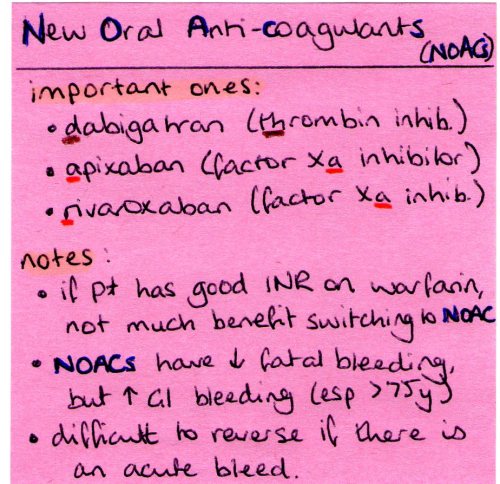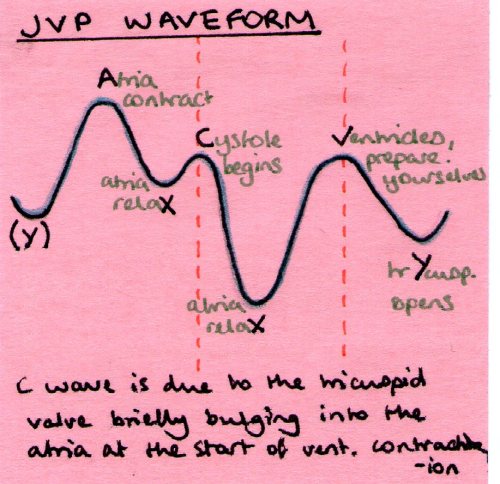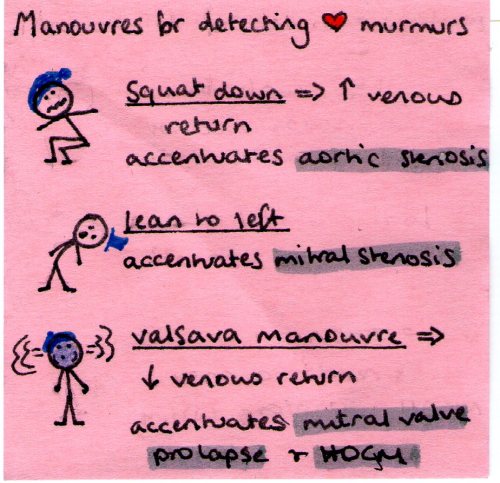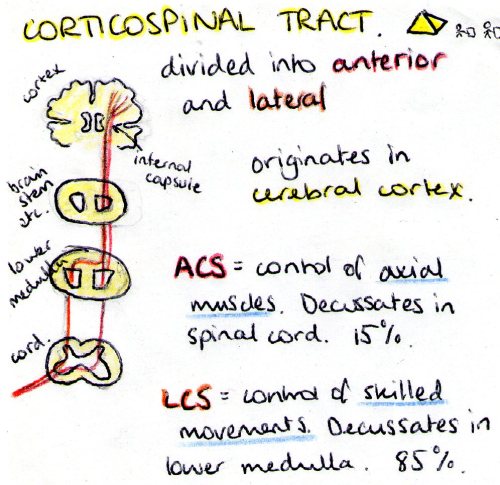#medical school
In honour of Valentine’s Day, a heart filled mnemonic for remembering the immediate management of a myocardial infarction.
Post link
These are mostly used in patients with AF, though apixaban is also used to prevent VTEs in patients have hip or knee replacement.
One of my homework items from my consultant this week was to research the new anticoagulants that are currently gaining popularity. His rationale was that by the time I’m the one prescribing them, they’ll probably be much more common than they are now. Which is true, but as they aren’t likely to come up in my exam I kind of don’t need to be learning this shit right now.
Still, it’s pretty interesting. Medicine is cool :)
Post link
I can never remember what the different bits are on a JVP wave so here is a way to try and remember it. It’s a bit contrived, what with Cystole and trYcuspid but silly things are easier to remember.
C is the tricuspid valve closing and kind of bulging as it does. Imagine it over shooting ever so slightly then recoiling back into place.
V is the atria refilling, hence why the ventricles need to prepare for the next onslaught.
The letter refers to the bit of waveform that happened just before it. So when the atria contract they cause a bit of backflow, so the pressure in the jugular vein increases (there’s no valve into the atria, only out) causing the upswing. Then the atria relax so blood can flow into said atria, so the jugular vein empties and the pressure goes down.
Just remember that it’s the JUGULAR VENOUS pressure. Not the right atrial pressure. They’re similar, but not the same.
Post link
Amsel criteria for diagnosis of bacterial vaginosis. It occurs when the balance of bacteria that naturally occur in the vagina becomes disrupted (usually the lactobacilli number goes down), so some get to predominate leading to symptoms of an infection. IT IS NOT AN STI. One of the common causes is excessively cleaning the vagina. Patients like it when you emphasise this.
Usually they’re anaeroboes so treat them with metronizadole. No need to treat the partner. Tah dah.
Post link
For looking swish in an OSCE.
Also an SBA question setter’s dream.
Though the types of patients who get aortic stenosis are generally not the type that are even able to squat so it’s a bit academic.
Post link
A brief overview of the features of HHT.
Treatment is symptomatic - deal with problems as they arise. Cautery, embolisation, iron supplements, etc. Generally patients have a normal lifespan, with nosebleeds being the most problematic feature.
Post link
Believe it or not, if you google “pandas” this disease does in fact make an appearance on the first page. Didn’t the consultant feel silly though when he typed it in and the first thing that appears is all these pictures of pandas.
It’s a bit obscure, but it is the abrupt onset (or sudden dramatic worsening) of OCD and/or Tourette like syndromes following infection with group A beta haemolytic strep - such as with strep throat and scarlet fever. It is thought it might be an autoimmune response (“molecular mimicry” which is a term I have fondness for), similar to sequale of rheumatic fever (valve disease, chorea).
Mostly I felt like drawing a panda. I copied it from this guy.
Post link
Some associations of Dupuytrens contracture that are useful to be aware of. Some are well established (family history) and some are quite tenuous (manual labour) but are still worth asking about in a history.
Post link
I had an ask recently for the books I use, so I thought I’d give a bit of a run down of the ones I like. All of this is very UK leaning unfortunately.
Clinical books
Oxford Handbook of Clinical Medicine - always useful for an overview. Seem that most consultants either love it or hate it. I like to use it when structuring my notes, but it doesn’t always go into all the detail I want.
Other Oxford Handbooks I’ve liked: Clinical Specialities, Foundation Programme.
Kumar & Clarke - I don’t actually use this as much as I should, but it’s good when trying to get some revision done when the computer is off. It’s usually much faster to google my query. Explains things really well though and has nice diagrams. I now have a mini version as well which I can see myself using more than the giant one.
Clinically Oriented Anatomy - my preferred resource. Others like Gray’s. COA has simpler pictures, and fewer errors.
BNF - always useful.
The ECG Made Easy - I learnt ECGs from this book. Went through meticulously and made notes. Obviously you need to practice (The ECG In Practice) and correlate clinically, but the Saturday I spent with this book was an exceedingly useful one.
Pre-clinical books
Color Atlas of Histology - I like histology
Langman’s Medical Embryology - makes sense of the gobbledegook that is sodding embryology (the most dreaded lectures of each module)
Anatomy Coloring Book - for procrastination. Doesn’t really matter which one you get, the amount you actually learn from doing it is limited.
Online Resources
eBNF - because who uses paper copies these days anyway? I think you need a login, can’t remember how to get that.
Passmedicine - for SBA practice. Costs £22 for the whole year, and includes SJT practice questions which will be usesful come December time….
Fastbleep - really nicely written up medical notes on different conditions, with pathophysiology etc. Doesn’t have all topics, but has a LOT.
Wikipedia - it shouldn’t be, but it is, and I have no shame.
More detailed post-it of the corticospinal tracts, showing the two tracts and their decussation.
Post link












